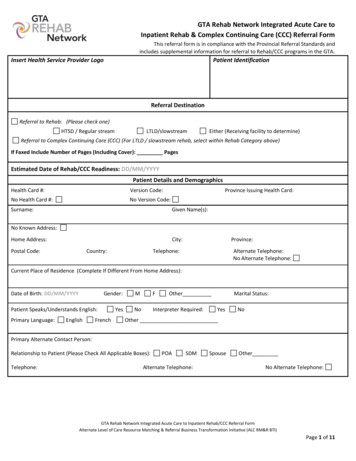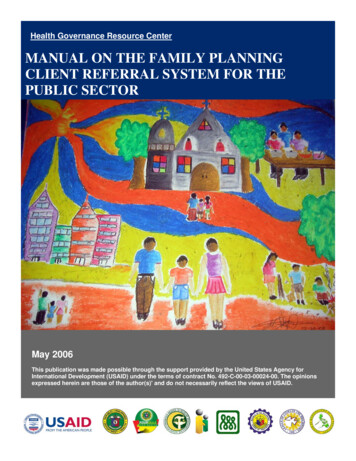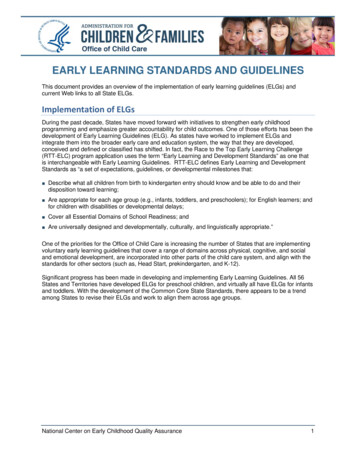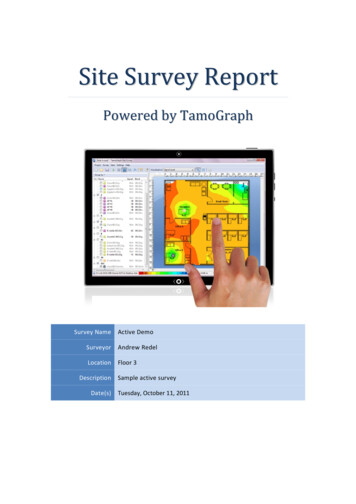
Transcription
Referral to treatment (RTT)waiting times statistics forconsultant-led electivecare2017/18 Annual Report
Referral to treatment (RTT) waiting times statistics for consultantled elective care2017/18 Annual ReportVersion number: 1First published: 14th June 2018Updated: N/APrepared by: NHS England, Operational Information for CommissioningClassification: OFFICIAL
Contents1.Summary . 11.1 Incomplete pathways . 11.2 Completed admitted pathways . 11.3 Completed non-admitted pathways . 12.3.Introduction . 2Key terms . 33.1 RTT pathway . 33.2 Incomplete pathway . 33.3 Admitted pathway . 33.4 Non-admitted pathway . 43.5 RTT waiting time rights and pledges . 43.6 Operational waiting time standard . 44.RTT waiting times . 64.1 Operational waiting time standards . 64.2 Average waiting times . 84.3 Incomplete Pathways and Activity .105.6.7.RTT waiting times by specialty . 15RTT waiting times by region . 17Methodology . 187.1 Data collection.187.2 Additional data items .187.3 Data availability .207.4 Data coverage .207.5 Data revisions . 27.6 Data comparability . 28.9.10.Glossary . 4Additional information . 6Annex . 7
1.Summary1.1 Incomplete pathways1.1.1 As at the end of March 2018, 87.2% of patients waiting to start treatment(incomplete pathways) had been waiting up to 18 weeks.1.1.2 Nationally, the operational standard for incomplete pathways was not metthroughout 2017/18.1.1.3 At the end of March 2018, 92% of patients had been waiting less than 21.9weeks to start treatment (this is the 92nd percentile waiting time).1.1.4 The number of RTT patients waiting to start treatment at the end of March2018 was 3.84 million. Of those, 2,755 had been waiting more than 52 weeks.1.1.5 Factoring in estimates based on the latest data submitted for missing trustssuggests the total number of RTT patients waiting to start treatment at the endof March 2018 may have been 4.1 million.1.1.6 Since August 2013, there has been a reduction in the percentage ofincomplete pathways within 18 weeks in every month compared to the samemonth in the previous year. During 2017/18, performance ranged from 90.4%(May 2017) to 87.2% (March 2018).1.1.7 Since April 2012, the RTT waiting list has been at a higher level each monththan the same month in the previous year. During 2017/18, the waiting listwas on average 160,000 pathways (or around 4%) higher each month whencompared to the previous year, including estimates for missing data.1.1.8 For patients on incomplete pathways, the median waiting time at the end ofMarch 2018 was 6.9 weeks.1.2 Completed admitted pathways1.2.1 In 2017/18, 14,500 patients started admitted treatment per working day,compared to 15,100 in 2016/17 (a decrease of 3.7%), including estimates formissing trusts.1.2.2 In 2017/18, the median wait for admitted treatment was 10.0 weeks.1.3 Completed non-admitted pathways1.3.1 In 2017/18, just under 51,000 patients started non-admitted treatment perworking day, compared with approximately 48,700 in 2016/17 (an increase of4.7%), including estimates for missing trusts.1.3.2 In 2017/18, the median wait for non-admitted treatment was 5.9 weeks.
2.Introduction2.1.1 This report presents a summary of English NHS referral to treatment (RTT)waiting times statistics for consultant-led elective treatment up to March 2018.2.1.2 Patients have a legal right under the NHS Constitution to access serviceswithin maximum referral to treatment waiting times, or for the NHS to take allreasonable steps to offer them a range of alternative providers if this is notpossible. The continued publication of waiting times information will ensurethat the NHS is accountable to the patients and public it serves. Thisinformation, combined with the quality of patients’ experiences and outcomes,will inform patients’ choices of where they want to be treated.2.1.3 The incomplete pathway operational standard is the measure of patients’constitutional right to start treatment within 18 weeks.2.1.4 The United Kingdom Statistics Authority has designated these statistics asNational Statistics, in accordance with the Statistics and Registration ServiceAct 2007 and signifying compliance with the Code of Practice for OfficialStatistics.2.1.5 The Government Statistical Service (GSS) statistician with overallresponsibility for the data in this report is:Debbie MoonOperational Information for Commissioning – Activity and PlanningNHS EnglandRoom 5E24, Quarry House, Leeds LS2 7UEE-mail: england.rtt@nhs.net
3.Key termsThe following are key terms used in this report. For a more comprehensivelist of terminology, please see the glossary.3.1 RTT pathwayPatients referred for non-emergency consultant-led treatment are on RTTpathways. An RTT pathway is the length of time that a patient waited fromreferral to start of treatment, or if they have not yet started treatment, thelength of time that a patient has waited so far.The following activities end the RTT pathway: first treatment – the start of the first treatment that is intended tomanage a patient’s disease, condition or injury in a RTT pathway start of active monitoring initiated by the patient start of active monitoring initiated by the care professional decision not to treat – decision not to treat made or no further contactrequired patient declined offered treatment patient died before treatment.Each pathway relates to an individual referral rather than an individualpatient so if a patient was waiting for multiple treatments they may beincluded in the figures more than once. Where we refer to the number of‘patients’ waiting or starting treatment in this report, technically, we areconsidering the number or percentage of ‘pathways’.3.2 Incomplete pathwayIncomplete pathways, often referred to as waiting list times, are the waitingtimes for patients waiting to start treatment, as at the end of each month.The volume of incomplete RTT pathways is often referred to as the size ofthe RTT waiting list.The incomplete waiting time standard was introduced in 2012 and statesthat the time waited must be 18 weeks or less for at least 92% of patients onincomplete pathways. For more information see section 3.6.3.3 Admitted pathwayAdmitted pathways are the waiting times for patients whose treatmentstarted during the period and involved admission to hospital. These are alsooften referred to as inpatient waiting times. They include the complete timewaited from referral until start of inpatient treatment. Although data on
admitted p
month in the previous year. During 2017/18, performance ranged from 90.4% (May 2017) to 87.2% (March 2018). 1.1.7 Since April 2012, the RTT waiting list has been at a higher level each month than the same month in the previous year. During 2017/18, the waiting list was on average 160,000 pathways (or around 4%) higher each month when










